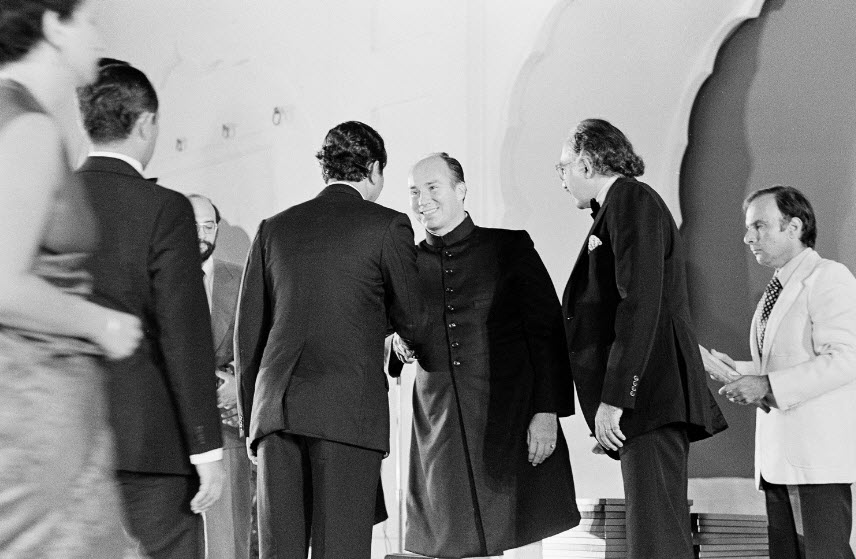Mawlana Hazar Imam presented the first awards of the Aga Khan Award for Architecture on October 23, 1980 at the Shalimar Gardens in Lahore, Pakistan.



Established in 1977 by Mawlana Hazar Imam, the Award is presented every three years, governed by a steering committee chaired by Hazar Imam. A new committee is formed for each cycle that determines the eligibility criteria for project submissions, provides thematic direction in response to emerging priorities and issues, and develops plans for the future of the Award. The steering committee is responsible for the appointment of an independent master jury for each cycle, and for the Award’s programme of international seminars, lectures, exhibitions, and publications. The master jury selects the projects that will receive the Award (AKDN).

“Within life’s span, there are days of special happiness, days of pride and days of humility. This is such a day for me. It represents the culmination of a vigorous effort, hope, and deep conviction that a significant change can be achieved in the environment in which Muslims live….
First, let me recall that it was here in Pakistan that the idea of this Award was made public, some four years ago. It is in part for this reason that the first recipients of the Award are gathered here to be recognised for their achievements. It is also in Pakistan that this event takes place because, located roughly in the geographical centre of Islam, Pakistan possesses some of the wonders of classical Islamic architecture, like the gardens which surrounds us, some of the most genuine vernacular tradition….
In the contemporary world, the Awards have recognised that other part, perhaps now much more important than in the past, the part of the common man creating for himself and his neighbours a setting for life and for health, preserving and utilising what nature has created, developing ways to maintain his identity rather than accepting the elephantine massiveness of so much of today’s world…
It is the expression of that social concern for thousands of separate communities within the whole Ummah which is so uniquely a central part of the Muslim message. We have recognised an architecture for men, women, and children, not yet an architecture for history books and tourists. Through architecture we are recognising the quality of life within the Muslim world today. And, by recognising a housing project developed by a whole community or a medical centre, we are preserving for all times the memory of this quality of life.
… The issue is: what architecture are we recognising? Is it the planning and design of master architects? Is it the architecture of the craftsmen, artisans, and specialists of all sorts who put a building together? Is it the architecture of users? Is it the architecture of certain lands with their peculiar physical characteristics? Is it the architecture of a faith which transcends national, geographic, social, or technological limits?…
The implication is that we are recognising as unique a creative and generative process in which the imagination of one architect or the expectation of Muslim patrons and users interact constantly. Within this continuum no single moment or decision can be isolated like the element of a chemical compound, because its creative life itself, it is the elusive process of human existence which is the winner, not merely a monument.
…the Award process itself is designed to be one of the means for this collective search. A partial failure can be as important as a unique success. It is in this spirit of common search for solutions to thousands of problems that these Awards will play their part. It is a spirit which is well proclaimed in the Muslim message, for the intention of man (the niyah) is a fundamental part of his action…
From the travails and labours of thousands, humble masons or expensive experts, there have emerged those works made by us and for us which we can present as being, all together, as an aggregate, as a group, the statement of our hopes and of our expectations as much as of our achievements…
Let me close, therefore, by reminding you of Attar’s great poem, the Conference of the Birds, Mantiqat at-Tayr. The birds, you will recall, in huge quantities went in search of the Simurgh, the ideal and perfect king. After my tribulations, thirty of them do reach the end of the journey and come to the gate of the Supreme Majesty. The Chamberlain tests them and then opens the door and they sit on the masnad, the seat of the Majesty and Glory. And, as an inner glow came into them, they realised that it is they together who were the Simurgh and that the Simurgh was the thirty birds…. Is this not what these Awards mean?….”
Mawlana Hazar Imam
Lahore, Pakistan, October 23, 1980
Speech
1978-1980 Cycle
Steering Committee
Master Jury
Award Recipients
Publication
Shalimar (“Abode of Love”) Gardens

The Shalimar Gardens were commissioned by Prince Khurram in 1620, and further extended by him in 1634 after he succeeded his father to the Mughal throne as Shah Jahan (r. 1628-1658). Originally the Gardens were known as the Bagh-i Faiz Bakhsh (“Besotwer of of Plenty”) and Bagh-i Farah Bakhsh (“Joy Imparting”), the the names of the gardens forming the Shalimar. Beginning in 1654, the gardens came to be referred to as Shalimar Bagh (Vaughan, Islam Art and Architecture p 478).


Sources:
Philippa Vaughan, “Architecture of the Great Mughals,” in Islam: Art and Architecture Edited by Markus Hattstein and Peter Delius, Konemann, 2000
Shalimar Gardens, Archnet
